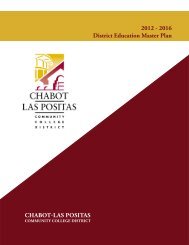City College of San Francisco - California Competes
City College of San Francisco - California Competes
City College of San Francisco - California Competes
Create successful ePaper yourself
Turn your PDF publications into a flip-book with our unique Google optimized e-Paper software.
THEME IV<br />
I. Overview<br />
<strong>City</strong> <strong>College</strong> <strong>of</strong> <strong>San</strong> <strong>Francisco</strong> has a cyclical planning, evaluation, and improvement process that increasingly<br />
focuses on student progress, achievement, and success. This essay examines selected cases at CCSF,<br />
widely ranging from a re-engineering study <strong>of</strong> Admissions and Records and an Architecture Department<br />
Program Review, to an evaluation <strong>of</strong> noncredit ESL promotion testing and a re-organization <strong>of</strong> Financial<br />
Aid. These cases vary greatly in scope and focus, but each in its own way provides insight into the principal<br />
parts <strong>of</strong> the planning cycle and demonstrates how our system provides the climate, the expectation,<br />
and the structure for continuous improvement through both periodic and non-periodic means. First, the essay<br />
examines the institutional context; then, through review <strong>of</strong> selected cases, demonstrates that our planning<br />
and budgeting system is flexible, well-organized, and even nimble. It will be clear that the primary focus<br />
<strong>of</strong> the system is supporting the improvement <strong>of</strong> teaching and learning.<br />
II. Institutional Context<br />
<strong>City</strong> <strong>College</strong> <strong>of</strong> <strong>San</strong> <strong>Francisco</strong> uses both formal and informal processes to evaluate and improve its programs<br />
and services. Since the 1992-93 academic year, the <strong>College</strong> has used the current Program Review<br />
System to evaluate programs and services and to assess strengths and areas needing improvement. Since<br />
2000-01, the <strong>College</strong> has benefited from a comprehensive planning and budgeting system with mid-year<br />
and end-<strong>of</strong>-year assessments that provide key information about the progress <strong>of</strong> <strong>College</strong> units in meeting<br />
their annual objectives. The third process for evaluating <strong>College</strong> programs and services takes place at the<br />
operational level <strong>of</strong> the institution, among faculty, staff, and students, who identify problems and seek<br />
institutional support to find and implement remedies. All three <strong>of</strong> these processes are part <strong>of</strong> a growing<br />
“culture <strong>of</strong> evidence,” enabling administrators, faculty, staff, and students to address issues based upon<br />
<strong>College</strong> data. Such data may be generated through surveys or the <strong>College</strong>’s Decision Support System,<br />
which is accessible to everyone in the institution.<br />
Program Review. The Program Review System requires most instructional, student development, and<br />
administrative units to conduct a self study once every six years. Each <strong>College</strong> unit must conduct a<br />
comprehensive examination <strong>of</strong> its mission, role, and function, and assess how well it is carrying out its<br />
goals and objectives. The Office <strong>of</strong> Research, Planning and Grants provides relevant data, including statistics<br />
on unit productivity, student performance, and student satisfaction. Each unit is expected to review<br />
and analyze its datasets, and address how the unit’s work aligns with the <strong>College</strong> Strategic Plan. All units<br />
must create a six-year plan for review by the Program Review Committee, a <strong>College</strong> Shared Governance<br />
committee, and senior administration.<br />
Planning and Budgeting System. The second <strong>College</strong> process for evaluation and improvement is the<br />
<strong>College</strong> Planning and Budgeting System. This has been fully operational since 1999-00 and includes the<br />
following five components: (1) the Strategic Plan 2003-2008, adopted in February 2003, which includes<br />
eight strategic priorities for improvement and is supplemented by the <strong>College</strong> Education Master Plan<br />
(adopted in February 2003), the Facilities Master Plan, the Technology Plan and the Institutional<br />
Advancement Plan; (2) the Annual Plan, which derives its objectives primarily from the Strategic Plan<br />
and a companion document, the Strategic Plan Implementation Schedule, which, taken together, provide<br />
priorities and timetables for the annual plans <strong>of</strong> the <strong>College</strong>; (3) Cost Center Plans, which are the means<br />
for programs, departments, and <strong>of</strong>fices to identify one-year objectives and activities that support the<br />
objectives <strong>of</strong> the Annual Plan; (4) the CCSF Budget, which is a one-year fiscal plan detailing the resource<br />
CITY COLLEGE OF SAN FRANCISCO<br />
295







